|
|
|
Sort Order |
|
|
|
Items / Page
|
|
|
|
|
|
|
| Srl | Item |
| 1 |
ID:
166352
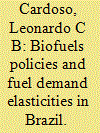

|
|
|
|
|
| Summary/Abstract |
Biofuels are often seen by policymakers as solutions to concerns about the environment, energy diversification, and rural development. To understand the impacts of biofuel policy, however, it is important to understand demand elasticities. Brazil, a leader in biofuels, provides a unique setting to increase our knowledge about biofuel policy and the interactions within and between the gasoline and ethanol markets. We estimate own-price, cross-price, and income elasticities of the demand for ethanol and gasoline using a novel instrumental variable approach to control for the inherent endogeneity between supply and demand. This results in own-price elasticities for both fuels higher than previous literature suggests: approximately − 0.9 for gasoline and − 1.5 for ethanol. Income elasticities for both fuels are approximately 0.8. We also examine the elasticity impacts following the introduction of flex-fuel cars into the Brazilian market. By estimating the model with over 100 subsamples across time, we find that cross-price elasticities become positive, significant, and increasing, but only after larger market penetration of flex-fuel cars, which occurred approximately three years after their introduction.
|
|
|
|
|
|
|
|
|
|
|
|
|
|
|
|
| 2 |
ID:
149770
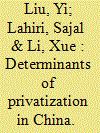

|
|
|
|
|
| Summary/Abstract |
This study investigates how the presence of foreign firms in a sector influences the privatization policy of domestic firms in that sector in China. We consider several variables to proxy for such a presence, from the perspective of the relative production scale, R&D and marketing, and labor productivity. By using the enterprise surveys carried out by the World Bank in 2005 of nearly 12,400 Chinese firms located in over 100 cities, we find that a rise in the presence of foreign firms increases the extent of the private ownership of domestic firms in a nonlinear fashion. Additionally, we apply IV-Tobit estimation with valid instruments and Tobit estimation with lagged key variables to deal with the possible endogeneity in the relationship between the presence of foreign firms and the privatization decision. Empirical evidence supports the main findings.
|
|
|
|
|
|
|
|
|
|
|
|
|
|
|
|
| 3 |
ID:
181473


|
|
|
|
|
| Summary/Abstract |
This paper advances research in the resource curse literature in several directions. Firstly, using different measures of oil dependence and abundance, it investigates the validity of the oil curse hypothesis in energy-rich developing countries. Secondly, the paper studies the impact of human capital, institutional quality, and trade openness on the growth of these countries. Thirdly, it examines the interaction effect of human capital and oil dependence/abundance on the growth of oil-rich developing counties. Fourthly, we estimate a set of panel data models by the Generalized Method of Moments (GMM) to address the endogeneity problem. The estimation results confirm the oil curse hypothesis. Furthermore, our findings underscore the significant role of higher human capital, better institutional quality, and trade openness in boosting economic growth. These results are robust to the way the quality of institutions is measured. Moreover, we find a threshold level for human capital above which the oil curse vanishes. Our finding, hence, highlights the crucial role of human capital in offsetting the adverse effect of oil abundance/dependence on output growth. The fact that poor quality of human capital and weak institutions hinder economic growth has important policy implications for social planners and policymakers in oil-rich developing countries.
|
|
|
|
|
|
|
|
|
|
|
|
|
|
|
|
| 4 |
ID:
149773
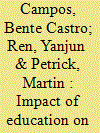

|
|
|
|
|
| Summary/Abstract |
This article analyzes the impact of education on income inequality between ethnic minorities and Han in China by using the data from the China Health and Nutrition Survey (CHNS) over the period 1993–2011. An instrumental variable approach using two institutional changes is applied to address the endogeneity of education in income equations for various subsamples. To investigate the impact of education on income inequality between ethnic minorities and Han, we introduce an interaction term between the ethnic minority status and years of education. Our results suggest that there exists significant income inequality to the disadvantage of ethnic minorities for the full, female, and urban samples, and depending on the instrument also for the rural sample. Nevertheless, our results for these samples show specific returns to education for ethnic minorities, which implies that a portion of the income gap can be overcome with additional education. We find that in general one additional year of education will increase earned incomes of ethnic minorities by 26.3–28% and in particular by 13.5–14.4% for women from an ethnic minority group, by 10.4–14% for ethnic minorities with urban household registration, and by 10.8% for ethnic minorities with rural household registration. However, we cannot obtain conclusive results for the male sample due to weak instruments.
|
|
|
|
|
|
|
|
|
|
|
|
|
|
|
|
| 5 |
ID:
091029
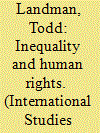

|
|
|
|
|
| Publication |
2009.
|
| Summary/Abstract |
This article tests the empirical relationship between inequality and the protection of personal integrity rights using a cross-national time-series data set for 162 countries for the years 1980-2004. The data comprise measures of land inequality, income inequality, and a combined factor score for personal integrity rights protection, while the analysis controls for additional sets of explanatory variables related to development, political regimes, ethnic composition, and domestic conflict. The analysis shows robust support for the empirical relationship between income inequality and personal integrity rights abuse across the whole sample of countries as well as for distinct subsets, including non-communist countries and non-OECD countries. The hypothesized effect of land inequality is also born out by the data, although its effects are less substantial and less robust across different methods of estimation. Additional variables with explanatory weight include the level of income, democracy, ethnic fragmentation, domestic conflict, and population size. Sensitivity analysis suggests that the results are not due to reverse causation, misspecification or omitted variable bias. The analysis is discussed in the context of inequality and rights abuse in specific country cases and the policy implications of the results are considered in the conclusion.
|
|
|
|
|
|
|
|
|
|
|
|
|
|
|
|
| 6 |
ID:
173889
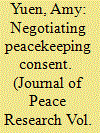

|
|
|
|
|
| Summary/Abstract |
The mixed record on civil war termination shows that it is a difficult task, one fraught with uncertainty and risk. Gaining consent for peacekeeping is one strategy policymakers and scholars forward to reduce these concerns. Formal and informal work argues that allowing peacekeeping serves as a costly signal of peaceful intentions; however, these models treat peacekeeping costs as exogenous. I argue that peacekeeping costs have an endogenous element and use consent for peacekeeping missions as a proxy measure. Three conclusions are evident. It is difficult to determine whether belligerents are insincere actors in a peace process or merely distrustful, but consent can tell us whether a ceasefire is precarious and therefore more likely to fail; peacekeeping is difficult but meaningful under some conditions, and reliable information can be taken from negotiating, not just war-fighting. These results qualify the extent to which peacekeeping, with its changing emphasis on consent, can improve its outcomes.
|
|
|
|
|
|
|
|
|
|
|
|
|
|
|
|
| 7 |
ID:
142040


|
|
|
|
|
| Summary/Abstract |
Based on spatial panel regressions for 1990–2012, this article draws publicness differences between peacekeeping personnel contributions to UN and non-UN peacekeeping operations. The analysis shows that UN missions are much less responsive to personnel spillovers, derived from other contributors’ peacekeepers, than is the case of non-UN missions. UN peacekeeping missions display either no response or free riding to these personnel spillovers, while non-UN missions indicate spillover complementarity. Moreover, a number of controls distinguish the two kinds of peacekeeping, where non-UN missions display income normality and UN missions’ deployments increase with the number of concurrent peacekeeping missions. The latter suggests that some countries specialize in supplying UN peacekeepers as a money-making venture. The positive response to the population variable supports this conjecture for UN missions, because a greater population base provides the recruits for peacekeeping operations. Our spatial empirical analysis accounts for the endogeneity of peacekeeper spillovers. The article concludes with a host of robustness tests that account for the alternative classes of peacekeepers, African Union and ECOWAS missions, and other empirical variants.
|
|
|
|
|
|
|
|
|
|
|
|
|
|
|
|
| 8 |
ID:
168507
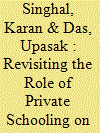

|
|
|
|
|
| Summary/Abstract |
In the view of increasing preference of private schooling in India, this article assesses its impact on learning outcomes for rural children from 8 to 11 years. Despite earlier attempts to study the issue, this article stands out in two ways. Firstly, it addresses the problems arising because of non-random selection of children attending private schools. Secondly, it also presents an all-India estimate unlike most studies which have dealt largely with few states. Our results show the performance of children attending private school to be significantly better than those from public schools. This difference is evident among ‘low-fee’ private schools as well. However the private schooling premium differ across regions and groups, and there are several other concerns regarding affordability, access and segregation which require further deliberation and debate.
|
|
|
|
|
|
|
|
|
|
|
|
|
|
|
|
| 9 |
ID:
193051
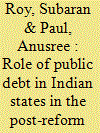

|
|
|
|
|
| Summary/Abstract |
The substantial amount of existing literature investigating the debt–growth association for high-income countries shows that debt has a negative impact on economic growth or the existence of an inverted U-shaped relationship between these two variables on some occasions. Given the lack of literature involving developing economies in this space, our study entirely focuses on a developing country like India. The study examines the empirical relationship between public debt (internal) and state gross domestic product (SGDP) for India in the post-reform era. The panel data extend from the year 2000 till 2020. Our random error component model findings indicate a positive and significant impact of debt in enhancing the Indian SGDPs for the above-mentioned period. Results are also confirmed by using an alternative estimation technique, namely, fixed effect. Next, we address the issue of endogeneity by employing generalized method of moments. Our results continue to remain robust. Finally, the inclusion of other control variables does not alter our findings.
|
|
|
|
|
|
|
|
|
|
|
|
|
|
|
|
| 10 |
ID:
144084
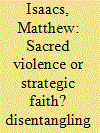

|
|
|
|
|
| Summary/Abstract |
Why are religious conflicts more violent than non-religious conflicts? Research has argued that religion pushes partisans toward violence. However, existing research suffers from widespread problems of measurement validity and fails to confront the possibility of endogeneity in the relationship between religion and violence. This article develops a more precise measure of the relevance of religion to conflict based on the use of religious rhetoric by political organizations. With this approach in mind, this article disentangles the causal sequence linking religious rhetoric and violence using annually coded data on the rhetoric of 495 organizations worldwide from 1970 through 2012. The analysis finds a strong general correlation between religious rhetoric and violence. However, past use of religious rhetoric does not increase the likelihood that an organization will participate in violence or the overall intensity of conflict. On the contrary, previous participation in violence makes an organization more likely to adopt religious rhetoric for mobilization. Indeed, religious rhetoric becomes more likely as violence increases in intensity and conflict continues for longer periods of time. These findings suggest that violent actors adopt religious rhetoric to solve the logistical challenges associated with violence, including access to mobilizing resources and recruitment and retention of members. This article contributes to the study of religious conflict by providing evidence of endogeneity in the relationship between religion and violence and highlighting the need for temporally sensitive measures of religious mobilization.
|
|
|
|
|
|
|
|
|
|
|
|
|
|
|
|
| 11 |
ID:
118515
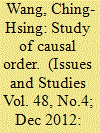

|
|
|
| 12 |
ID:
174829
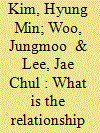

|
|
|
|
|
| Summary/Abstract |
Despite the importance of alliances in international politics, little is known about how they theoretically and empirically affect militarized conflicts and vice versa. This study aims to examine the reciprocal relationship between alliances and militarized conflicts. The literature has focused only on the effects of alliances on militarized conflicts without paying much attention to the simultaneous causation between them. Thus, previous studies have not consistently revealed a relationship between alliances and conflict. Moreover, they are limited due to the use of dichotomous measures of shared alliance ties. Using a continuous measure of alliance ties, this study clearly demonstrates that shared alliance ties can be effective in reducing the likelihood of militarized conflicts. In addition, this study finds that there is a reciprocal relationship between shared alliances and militarized conflicts. It finds that militarized conflicts tend to decrease the level of shared alliance ties. Then, this study argues that alliance might be added to the next element behind the Kantian tripod as a salient factor that reduces militarized conflict. Finally, this study points to insights to be gained from the findings and suggests some policy implications.
|
|
|
|
|
|
|
|
|
|
|
|
|
|
|
|
|
|
|
|
|